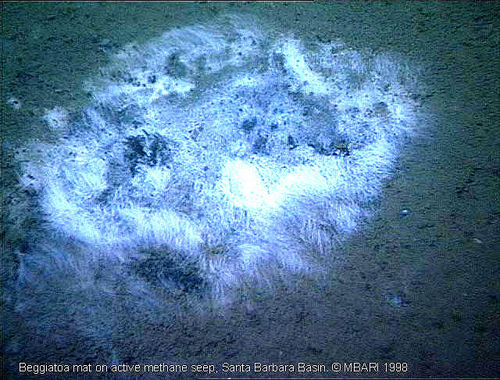Beggiatoa
A Microbial Biorealm page on the genus Beggiatoa

Classification
Higher order taxa:
Bacteria; Proteobacteria; Gammaproteobacteria; Thiotrichales; Thiotrichaceae
Species:
Beggiatoa alba
|
NCBI: Taxonomy |
Description and Significance
"Beggiatoa" is one of the first bacteria discovered by Sergie Winogradsky the father of modern geomicrobiology. Beggiatoa is a genus of colorless, filamentous proteobacteria. With cells up to 200 microns in diameter, species of Beggiatoa are among the largest prokaryotes. They are one of the few members of the chemosynthesizers, meaning that they can synthesize carbohydrates from carbon dioxide and water using energy from inorganic compounds. Beggiatoa are found in polluted marine environments, and can be seen by the naked eye as a white filamentous mat on top of the water as a sign of environmental deterioration.
Cell Structure and Metabolism

Image from Microbial Diversity 1997 (Rolf Schauder).
All strains of freshwater Beggiatoa demonstrate the ability to grow heterotrophically in the presence of oxygen, yet this growth tends to be limited by the lack of catalase in Beggiatoa species. Their reaction for hydrogen sulfide oxidation is:
2H2S + O2 --> 2S0 + 2H2O
The lack of catalase is compensated for by the organisms' ability to oxidize sulfide, which detoxifies metabolically-formed hydrogen peroxide in the absence of oxygen. Sulfide oxidation provides the bacteria with energy for growth on acetate, and is the sole energy source for at least one marine species. The cells are disk-shaped and are motile by a gliding motion. They can exist either as individual cells or as part of a tightly connected filament. Beggiatoa stores elemental sulfur on its outer membrane after using sulfur during respiration.
Ecology
Beggiatoa are evident in the marine environment as white filamentous mats on top of sulfide-rich sediments. They are found throughout the world's oceans, everywhere from shallow areas near land to the deep sea and around hydrothermal vents. In areas with overlapping sulfur and oxygen, sulfur bacteria perform diurnal vertical migrations, showing up at dark near the sediment surface. Mats tend to be 0.6 milimeters thick, but thickness varies depending on water movement. Beggiatoa tend to prefer areas that are rich in hydrogen sulfide, including water that has been contaminated with sewage. Because of this, the mats they form are good indicators of pollution in water.

References
Dudley, Michael. Beggiatoa. Biology Department, Virginia Polytechnic Institute and State University.
Marine Bacteria (Beggiatoa spp.) Benthic Habitats of NY/NJ Harbor. NOAA Coastal Services Center.
Nelson, Douglas C. et al. Organic Nutrition of Beggiatoa Species. Journal of Bacteriology vol 147(1) July 1981. 236-247.
Schauder, Rolf. Gradient organisms. Microbial Diversity Course, 1997, MLB, Woods Hole.
Schmidt, Thomas M. et al. Sulfur Metabolism in Beggiatoa. Journal of Bacteriology vol 169(12) December 1987. 5466-5472.
Silverside, Alan J. Beggiatoa. Biological Sciences, University of Paisley.
Ljungdahl LG (2003). Biochemistry and physiology of anaerobic bacteria. Springer. p. 17.
